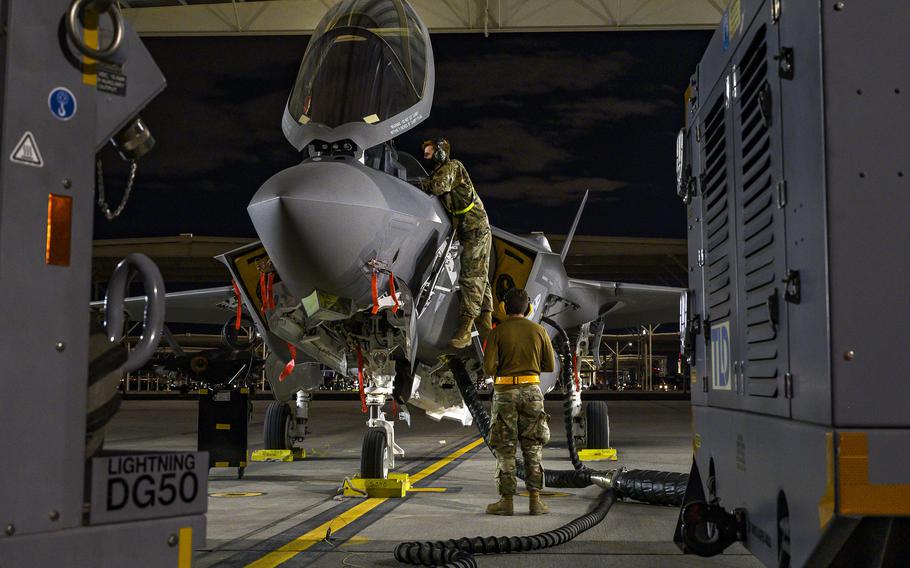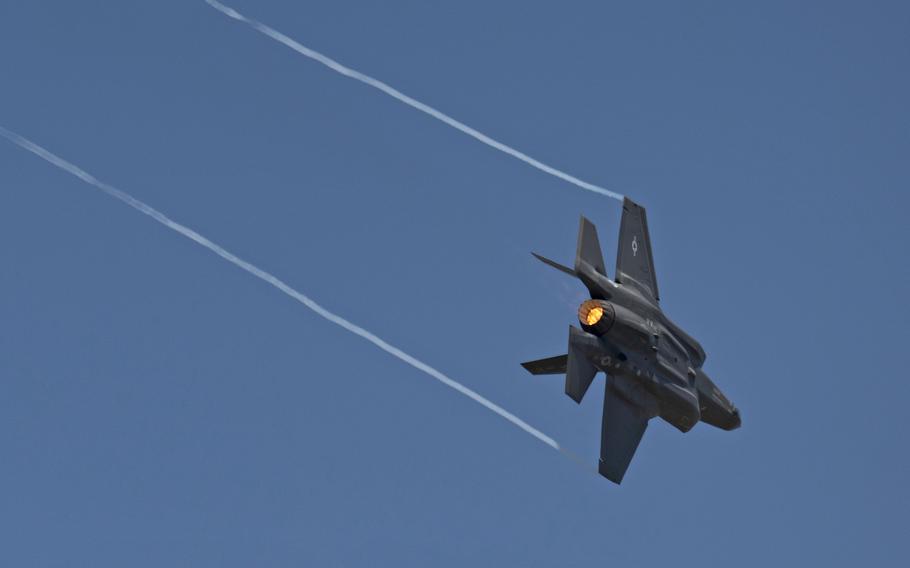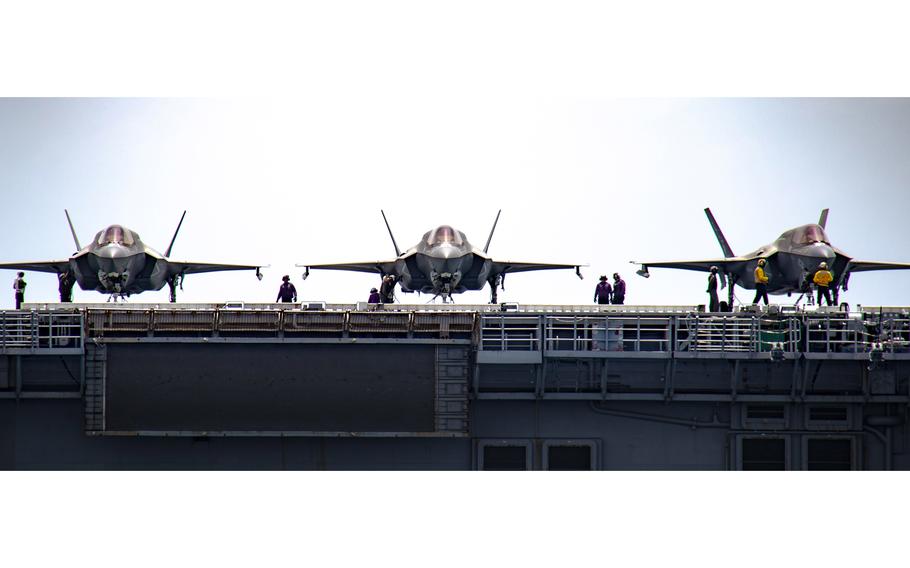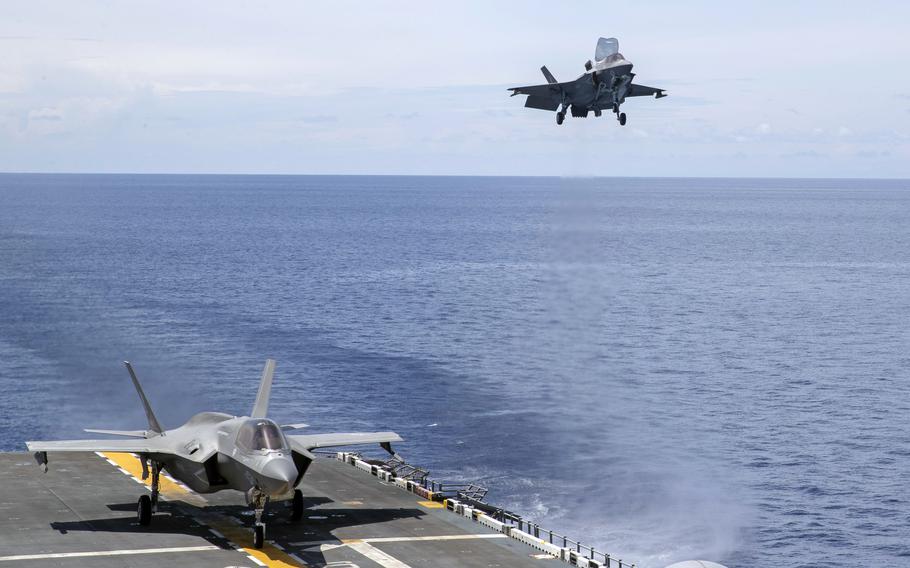
Airmen perform maintenance on an F-35 Lightning II fighter jet at Nellis Air Force Base, Nev., Feb. 2, 2021. The jet may fill a niche, rather than become the workhorse the Pentagon planned for, some analysts said. (Alexandre Montes/U.S. Air Force)
The costliest, most advanced U.S. fighter jet in history is flying less than a plane developed during the Reagan administration.
There’s little dispute that the F-35 Lightning II, which is flown with modifications by the Air Force, Marine Corps and Navy, can be a devastatingly effective weapon when it’s available.
But five years after joining the fleet on a regular basis, the Air Force F-35A is flying fewer hours per month than the F-15E Strike Eagle, which was first introduced in 1986, a recent report by the nonpartisan Congressional Budget Office found.
At its five-year mark, the F-15E was available at double the rate of the stealthy, cutting-edge F-35A.
The lack of availability is why some analysts say the F-35 may end up filling a niche in national defense instead of becoming the day-to-day workhorse first envisioned, despite a program cost of $1.7 trillion to buy, operate and sustain a planned 2,500 planes, according to 2022 government figures.
Ballooning F-35 costs have the Air Force, Marines and Navy reexamining their planned purchases, said Bryan Clark, director of the Hudson Institute’s Center for Defense Concepts and Technology.
The $1.7 trillion tab could challenge the Defense Department’s ability to fund other wants, such as the Next Generation Air Dominance fighter and the B-21 Raider, a sixth-generation bomber, Clark said.

Maj. Kristin Wolfe, F-35A Lightning II Demonstration Team commander and pilot, assigned to Hill Air Force Base, Utah, flies the F-35A during Aero India 23 at Air Force Station Yelahanka, Bengaluru, India, Feb. 14, 2023. (Emily Saxton/U.S. Air Force)
The F-35 is beset by engines that wear out faster than expected, a shortage of replacement parts and maintenance delays, among other problems, the CBO report found.
“The services are all looking for alternatives that allow them to reduce their flight hour costs and then husband their F-35s for … high-end missions that are less frequent than the day-to-day flying,” Clark said.
The CBO report noted that the F-35’s availability, or mission capable rate, has fallen sharply as the fighter ages, with the plane requiring more frequent maintenance and part replacement.
The jet also fared poorly on availability when compared with the F-22 Raptor, according to the report, which was released in February.
However, some analysts say the comparisons between the F-35 and older aircraft don’t take several factors into consideration.
There are just 450 fifth-generation F-35s in use across the services, said Heather Penney of the Mitchell Institute for Aerospace Studies, a think tank based in Arlington, Va.
The lack of additional F-35s means the first to join the fleet are being flown harder and aren’t being replaced with newer versions, Penney said.
“If you don’t have a chance to divest the very, very early (F-35) models because you don’t buy enough or you don’t buy them fast enough, you’re going to see that reflected in availability rates,” said Penney, a senior resident fellow.

F-35B Lightning II aircraft from Marine Fighter Attack Squadron 122, 13th Marine Expeditionary Unit, sit aboard the amphibious assault ship USS Makin Island in the South China Sea, Feb. 15, 2023. (David Rowe/U.S. Navy)
Part of the reason the F-35’s availability compares poorly with other planes in their early years is a shortage of thousands of maintainers in the Air Force, she said. The F-15 and F-22, for example, benefited from greater staffing, she said.
Penney advocates that the Air Force buy as many F-35s and spare parts as quickly as it can, given modernization efforts, upcoming financial obligations and the global security environment.
“When we hit the late 2020s and the early 2030s, we will have a significant demand on the Air Force to replace legacy platforms that really have already served longer than they should have,” Penney said.
However, there are indications that the services are prioritizing upgraded versions of earlier platforms, along with new programs.
For example, the Air Force is buying as many as 200 F-15EX Eagle II jets, which will be the backbone fighter of the force, manufacturer Boeing says on its website.
And the Pentagon proposed buying fewer F-35s this year than expected. Congress approved funding for as many as 11 more than the 33 planes requested for the Air Force, Air and Space Forces magazine reported in December.

F-35B Lightning II aircraft assigned to Marine Medium Tiltrotor Squadron 262 come in for landings aboard amphibious assault carrier USS Tripoli in the South China Sea, Aug. 30, 2022. (Peter Burghart/U.S. Navy)
Under the current DOD plan, the Air Force would get 1,763 of the F-35A variant; the Marine Corps would take 353 of the F-35B and 67 F-35C variants; and the Navy would receive 273 of the F-35C, according to manufacturer Lockheed Martin’s website.
Those numbers no longer appear to be realistic, forcing the services to consider other ways to fill out their fleets, Clark said.
Possibilities include relying on new purchases of older planes and using manned-aircraft collaborations with drones or drones alone to keep air wings full.
“So unmanned will increasingly take on some of the capacity requirements that previously manned aircraft would have met,” he said.
The CBO report also showed that the availability rate for the Air Force’s F-35 fleet fell 11% between 2021 and 2022. It dropped by 7% for the F-35B used by the Marines, while the Navy’s F-35C saw a gain of 5% over the same time period.
In 2022, availability of all three variations ranged from 54% to 58%, the CBO said.
Those trends are “problematic” but could improve as more planes are delivered and upgraded, said Daniel Norton, a senior management systems analyst at the Rand Corp., a California-based think tank.
“But there are no guarantees,” he said.